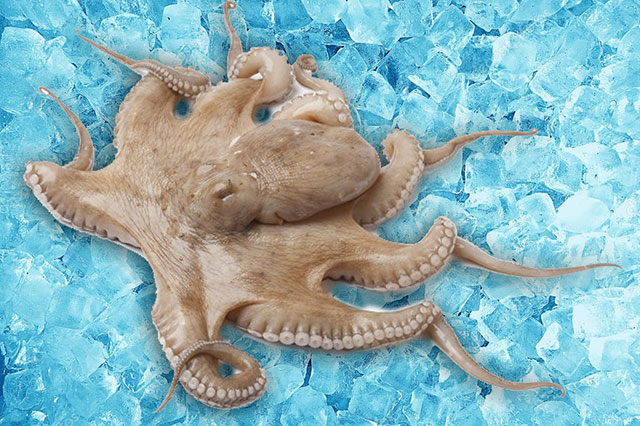
Octopus
Genus: Octopus vulgaris
Specification:
| Land | Packaging | *Mass | Type |
|---|---|---|---|
| Spain | Bulk | 10 kg | Whole |
* Mass of goods in a transport box packaging
Octopus vulgaris is considered cosmopolitan. A global[1] species, its range in the eastern Atlantic extends from the Mediterranean Sea and the southern coast of England to at least Senegal in Africa. It also occurs off the Azores, Canary Islands, and Cape Verde Islands. [2] The species is also common in the Western Atlantic.
The common octopus hunts at dusk. Crabs, crayfish, and bivalve mollusks (two-shelled molluscs such as cockles) are preferred, although the octopus will eat almost anything it can catch. It is able to change colour to blend in with its surroundings, and is able to jump upon any unwary prey that strays across its path. The prey is paralyzed by a nerve poison, which the octopus secretes in its saliva, and the octopus is able to grasp its prey using its powerful arms with their two rows of suckers.[citation needed] If the victim is a shelled mollusc, the octopus uses its beak to punch a hole in the shell before sucking out the fleshy contents.[citation needed]Training experiments have shown the common octopus can distinguish the brightness, size, shape, and horizontal or vertical orientation of objects. They are intelligent enough to learn how to unscrew a jar and are known to raid lobster traps.[4] [5] O. vulgaris was the first invertebrate animal protected by the Animals (Scientific Procedures) Act 1986 in the UK;[6] it was included because of its high intelligence.
Habitat
The common octopus is typically found in tropical waters throughout the world, such as the Mediterranean Sea and East Atlantic.[7] They prefer the floor of relatively shallow, rocky, coastal waters, often no deeper than 200 meters.[8] Although they prefer around 36 grams per liter, salinity throughout their global habitat is found to be between roughly 30 and 45 grams of salt per liter of water.[9] They are exposed to a wide variety of temperatures in their environments, however their preferred temperature ranges from about 15 °C to 16 °C.[9] In especially warm seasons, the octopus can often be found deeper than usual in order to escape the warmer layers of water.[10] In moving vertically throughout the water, the octopus is subjected to various pressures and temperatures which affect the concentration of oxygen available in the water.[9] This can be understood through Henry’s Law, which states that the concentration of a gas in a substance is proportional to pressure and solubility, which is influenced by temperature. These various discrepancies in oxygen availability introduce a requirement for regulation methods.
Primarily, the octopus situates itself in a shelter where a minimal amount of its body is presented to the external water, which would pose a problem for an organism which breathes solely through its skin.[12] When it does move, most of the time it is along the ocean or sea floor, in which case the underside of the octopus is still obscured.[12] This crawling increases metabolic demands greatly, requiring they increase their oxygen intake by approximately 2.4 times the amount that is required for a resting octopus.[13] This increased demand is met by an increase in the stroke volume of the octopus’ heart.
he octopus does sometimes swim throughout the water, exposing itself completely.[15] In doing so, the octopus uses a jet mechanism that involves creating a much higher pressure in their mantle cavity that allows them to propel themselves through the water.[14]As the common octopus’ heart and gills are located within their mantle, this high pressure also constricts and puts constraints on the various vessels that are returning blood to the heart.[14] Ultimately, this creates circulation issues and is not a sustainable form of transportation, as the octopus cannot attain an oxygen intake that can balance the metabolic demands of maximum exertion.
backHobotnica je važan stanovnik morskog dna, gde živi na stenovitim obalama i većinu vremena provodi u rupama ili raspuklinama stena u plitkoj vodi. Katkad krakovima prenosi kamenje i gradi neku vrstu „utvrđenja“ na morskom dnu. Hobotnica se kreće plivajući ili pužući po dnu na vrhovima krakova, a pri begu se kreće unazad. Po mogućnosti se povlači uvek u isto sklonište. Sklonište se prepoznaje po uredno naslaganom većem i manjem kamenju ispred rupe. Mogu se skrivati u polomljenim bocama, gumama od automobila, pukotinama u steni, morskoj travi itd. Hobotnica, bez obzira kolika je, provlači se u jako male prostore, može proći bilo gde kuda prolazi njena čeljust, ostali delovi tela su elastični i prolaze kroz prolaz. Mužjak se od ženke razlikuje po nešto većim prianjalkama.Danju većinu vremena provodi u svom skrovištu i pritom posmatra okolinu. Njene velike oči s kapcima prilagođene su prigušenom svetlu pod vodom, pa mogu razaznati gibanja i prepoznati strukture. Hobotnica je osetljiva na hladnoću i zbog toga mnoge od njih uginu zimi u plitkim predelima uz obalu zbog niskih temperatura mora. Hobotnica umočena u slatku vodu ugine za nekoliko sekundi. Ne može da živi ni u previše toploj niti u zagađenoj vodi. Voda je čista ako je nastanjuju hobotnice. Nikada se ne kreću po grupama negu uvek pojedinačno. Dešava se da često dolazi do sukoba između dve hobotnice oko skloništa. Borbu gubi slabija hobotnica i manja i mora da napusti sklonište.
nazad